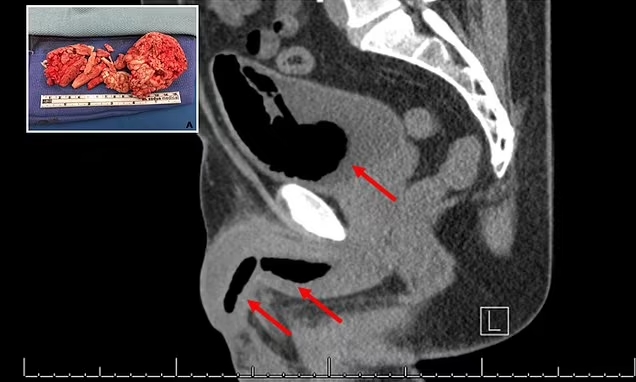Rents are about to soar, with 'most landlords' putting prices up by '5 per cent' within weeks, as 50,000 Chinese students rush to Australia after online study was banned.
China announced the sudden ruling on Saturday, banning studying online with foreign universities - including those in Australia - weeks before classes start.
In order to have their degrees recognised in the communist state, students now have to study in person at overseas universities, rather than online as they had done since 2020 due to the Covid-19 pandemic.
This means around 50,000 more people will compete with locals for Australian rental properties within weeks, sending prices soaring, especially in Melbourne, Sydney and Brisbane.
'Most landlords are going to be looking to put up rent,' said Cameron Kusher of the property advertising REA Group.
Students are pictured queueing to look at a rental property, with prices set to soar within weeks
'Now, obviously some people are going to be able to stomach that increase in rent (but) others won't be able to,' he told 7News.
Getting inner city apartments in the most popular Australian destinations for Chinese students will become particularly difficult, with bidding up likely to be a lot more common.
'A lot of the students that have come from overseas are relatively wealthy, so they can pay higher prices for these properties than maybe local students can,' Mr Kusher said.
Phil Honeywood, of the International Education Association of Australia said his organisation was 'taken by surprise' by the suddenness of the Chinese ruling.
'We were hoping for a longer transition period,' he said.
Mr Honeywood said China's former policy of only allowing families to have one child is also a huge factor on the coming rental property squeeze.
'We find that Chinese students, coming from one child only families, like to often have their own apartment,' he said.
Students are pictured at the University of New South Wales in Sydney. Rental prices are set to soar with the sudden influx of 50,000 Chinese students to Australia
Melbourne and Brisbane will also see huge numbers of Chinese students arriving within weeks. Pictured is the University of Melbourne
The unexpected sudden influx of 50,000 more people looking to rent comes on top of what had already become a rental crisis across Australia in the last 12 months.
Nationally, rents rose 6.7 per cent to a median of $495 per week in 2022, but the issue was much worse in capital cities.
In cities such as Melbourne and Sydney, higher post-Covid demand for fewer properties saw unit rents up by 9.3 per cent, while houses went up 8.3 per cent.
Kent Lardner, founder of Suburbtrends, said the return of Chinese students is likely to make the competition for apartments and houses 'rather fierce'.
'I expect to see rental increases of at least 5 per cent in the next four weeks or so,' he told the Australian Financial Review.
Mr Lardner said vacancies will 'quickly drop to below 1 per cent in most suburbs'.
Karen Zhang is one of the Chinese students taken by surprise at her country's sudden decision that people had to return to in person learning.
She has previously studied finance online with the University of New South Wales in Sydney from her home in Guangdong province in China.
But now she is desperate to get to Australia before classes start on February 20 to finish her last semester of study.
Her biggest problem will be finding someplace to live.
'My life plans have been disrupted … I planned to go to a city (in China) to work as an intern, and I have already got the offer and found accommodation there.
'Now I have to cancel everything and arrange to return to Australia immediately,' she told the ABC.
In capital cities in 2022 unit rents were up by 9.3 per cent, while houses went up 8.3 per cent
The Department of Education said it welcomed the return of Chinese students to Australia and that the ministers for education and home affairs were working with universities to address the 'short-term logistical issues' of the sudden change.
Melbourne migration agent Kirk Yan said student-visa applications had increased since the order was issued.
'In the long run, I believe it's a good sign that the international-student market enters the post-pandemic era,' he said.
Airlines flying from China to Australia are also struggling to cope with the sudden huge demand for flights.
They have been inundated with calls from students desperate to get onto already packed planes.
State and territory breakdown on advice for renters
State/territory
NSW
Victoria
Queensland
WA
SA
Tasmania
ACT
NT
How often can landlords increase rent for a periodic lease?
Once every 12 months for periodic leases.
Once every 12 months for periodic leases.
Once every 6 months.
Once every 6 months.
Once every 12 months. Rent cannot be increased in the first 12 months of the lease.
Once every 12 months, after the tenancy agreement began or was renewed.
Once every 12 months from the date of the last increase.
Once every 6 months and not within the first six months of the lease. Rents can only be increased if the right to do so has been written into the tenancy agreement.
How much notice must they give you?
At least 60 days (written notice).
At least 60 days (written notice)
At least 2 months (written notice). The notice must include the date and amount of increase.
At least 60 days (written notice).
At least 60 days (written notice).
At least 60 days (written notice).
At least eight weeks written notice.
At least 30 days written notice. The notice must state the intention to increase the rent, the amount increase and the date it changes.
Source: Each state/territory's Residential Tenancies Act.
Rental increases deemed 'excessive' are different in each location, but generally, rental bodies deem increases to be excessive if they are too different from similar market rents, if there's a sizeable difference compared to the current rent, or if the property has outstanding repairs needed.
'The key culprit is household formation'
Dr Thomas Sigler, the deputy head of the School of Earth and Environmental Sciences at the University of Queensland, explains the huge role the number of people in a dwelling plays in rental property availability.
'The key culprit is household formation. Typically we're inclined to correlate population growth with demand - so we need more dwellings for more people.
'Typically, 2.5 people was the median household size. But what happened during Covid was that household size reduced to 2.4 people.
During Covid the typical household size reduced from 2.5 people to 2.4 people. Pictured is a house for lease in Melbourne
'That doesn't sound like a lot, but it's a 4 per cent reduction. That means there are 4 per cent more renters looking for properties.
'The reason that happened is because people wanted more space during the pandemic. For example, people, rather than having three flatmates, had two flatmates plus a Zoom room.
'People wanted more space for their home offices, they didn't want as many roommates for health reasons, people wanted to move out from mum and dad's house, and that led to an uptake in household formation that outstripped supply.
'It wasn't population growth that outstripped supply, it was household formation that outstripped supply.'


















 English (United States) ·
English (United States) ·